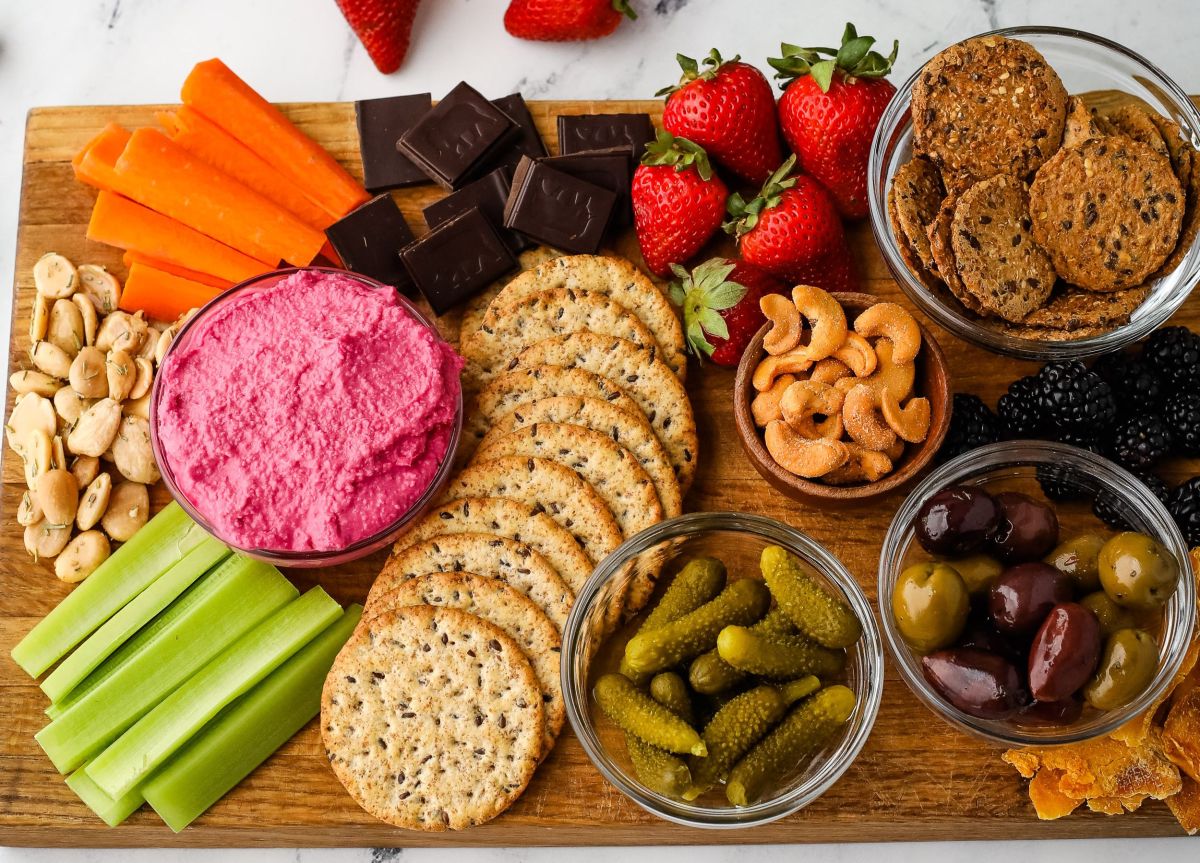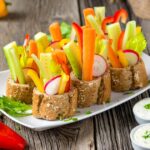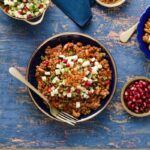Imagine a vibrant tapestry of colors, textures, and flavors, all arranged on a single board—a raw vegan charcuterie masterpiece. This isn’t your average cheese and crackers spread; it’s a celebration of fresh, vibrant ingredients, thoughtfully curated to delight the eyes and tantalize the taste buds. We’ll guide you through selecting the perfect organic produce, crafting creamy dips, and mastering the art of visually stunning arrangement, transforming your next gathering into a culinary adventure.
From the earthy richness of sun-dried tomatoes to the refreshing zest of lime, we’ll explore a world of raw vegan delights, uncovering nutritional benefits and flavor pairings that will elevate your charcuterie board to new heights. Learn to balance crunchy textures with smooth, creamy elements, creating a symphony of sensations that will leave your guests utterly captivated. Get ready to embark on a journey of culinary creativity!
Creating a Visually Appealing Arrangement

Arranging a raw vegan charcuterie board is as much about aesthetics as it is about taste. A thoughtfully composed board is a feast for the eyes, enticing guests and elevating the entire experience. Consider color palettes, textures, and heights to create a dynamic and visually stunning presentation.
Layout Strategies for a Raw Vegan Charcuterie Board
Three distinct layout strategies can transform your raw vegan charcuterie board from a simple collection of ingredients into a work of art. Each strategy leverages different principles of design to achieve a unique and appealing visual effect.
The Rainbow Cascade: This strategy utilizes a vibrant spectrum of colors, arranged in a cascading flow across the board. Imagine a spectrum of reds, oranges, and yellows at one end, gradually transitioning through greens, blues, and purples at the other. This creates a sense of movement and visual interest. Height is added by strategically placing taller items, like stacks of marinated artichoke hearts, at the back and gradually decreasing height towards the front.
The Circular Symphony: This layout focuses on creating concentric circles of color and texture. Begin with a central focal point, perhaps a vibrant bowl of marinated red peppers. Then, arrange ingredients in concentric rings, alternating colors and textures. For example, a ring of creamy cashew cheese could surround the peppers, followed by a ring of crisp vegetables, and finally a ring of darker, richer items like sun-dried tomatoes. The circular pattern is visually pleasing and creates a sense of harmony.
The Zestful Zigzag: This energetic layout employs a zigzag pattern to create visual dynamism. Imagine a bold line of bright yellow mango slices zigging across the board, followed by a zag of deep green kale chips. Continue this alternating pattern, using varying heights and colors to keep the eye moving. Consider using different-sized bowls and dishes to accentuate the zigzag effect and add depth.
Enhancing Visual Appeal with Serving Vessels and Garnishes
The choice of serving vessels and garnishes can significantly impact the overall aesthetic of your raw vegan charcuterie board. Using a variety of shapes, sizes, and materials adds depth and visual interest.
Consider using small, shallow bowls for dips and spreads, such as a vibrant green guacamole or a creamy cashew cream cheese. These bowls can be strategically placed throughout the board, adding pops of color and texture. Larger, rustic wooden bowls can hold larger items like marinated olives or roasted vegetables. Smaller, decorative bowls can house smaller items such as seeds or nuts.
Garnishes play a crucial role in elevating the visual appeal. Fresh herbs, such as sprigs of rosemary or cilantro, add pops of green and aromatic appeal. Edible flowers, like pansies or nasturtiums, add a touch of elegance and delicate color. A sprinkle of toasted nuts or seeds can add texture and visual contrast. Strategically placed pomegranate seeds add jewel-like pops of color.
Arranging Ingredients for a Balanced and Visually Stunning Presentation
The key to a visually stunning raw vegan charcuterie board is balance. Balance refers not only to the distribution of ingredients but also to the interplay of colors, textures, and heights. Aim for a variety of colors, textures, and flavors to create a dynamic and appealing presentation.
Start by placing larger items first, establishing a foundation for the rest of the arrangement. Then, fill in the gaps with smaller items, creating visual interest and texture. Consider using height variations to add dimension. Taller items can be placed at the back of the board, while smaller items can be placed in the front. Ensure there’s a good balance of colors and textures throughout the board, avoiding large blocks of a single color or texture. Don’t be afraid to experiment and find what works best for you. The goal is to create a visually appealing and delicious spread that will impress your guests.
Developing Flavorful Dips and Spreads
Creating delicious and visually appealing dips and spreads is crucial for elevating your raw vegan charcuterie board. The right dips can add a delightful array of textures and flavors, complementing the other components and creating a truly unforgettable experience. Think creamy, tangy, zesty – the possibilities are endless! The key is to balance flavors and achieve the right consistency for optimal spreadability and enjoyment.
Cashew Cream Cheese
This creamy, tangy dip provides a classic element to any charcuterie board. Its rich texture perfectly complements crisp vegetables and crackers.
| Dip Name | Ingredients | Instructions | Serving Suggestions |
|---|---|---|---|
| Cashew Cream Cheese | 1 cup raw cashews, soaked in hot water for at least 30 minutes; 1/4 cup lemon juice; 2 tablespoons nutritional yeast; 1 tablespoon water (more as needed); 1/2 teaspoon garlic powder; 1/4 teaspoon sea salt; Pinch of black pepper | 1. Drain and rinse the soaked cashews. 2. Combine all ingredients in a high-speed blender and blend until completely smooth and creamy, adding more water if needed to reach desired consistency. 3. Taste and adjust seasonings as needed. 4. Transfer to a serving bowl and chill for at least 30 minutes before serving to allow flavors to meld. | Pair with crackers, cucumber slices, bell pepper strips, or carrot sticks. |
The ideal consistency should be smooth and spreadable, like a traditional cream cheese. If it’s too thick, add more water, a tablespoon at a time, until you reach the desired consistency. If it’s too thin, add a few more soaked cashews to thicken it.
Sun-Dried Tomato Pesto
This vibrant pesto offers a burst of sun-dried tomato flavor and a satisfyingly chunky texture. The bright red color adds a beautiful visual contrast to the board.
| Dip Name | Ingredients | Instructions | Serving Suggestions |
|---|---|---|---|
| Sun-Dried Tomato Pesto | 1 cup sun-dried tomatoes, oil-packed, drained; 1/2 cup raw walnuts; 1/4 cup fresh basil leaves; 2 cloves garlic; 2 tablespoons lemon juice; 1 tablespoon water (more as needed); Salt and pepper to taste | 1. Combine all ingredients in a food processor and pulse until a coarse paste forms. Do not over-process; some texture is desirable. 2. Add water, a tablespoon at a time, if needed to achieve desired consistency. 3. Taste and adjust seasonings as needed. | Serve with toasted baguette slices, crudités, or alongside olives and marinated artichoke hearts. |
The desired texture for this pesto is a chunky paste, not a completely smooth puree. Avoid over-processing in the food processor to maintain the desired texture. Adjust the amount of water to achieve the right consistency for spreading.
Avocado Cilantro Lime Dip
This refreshing dip offers a vibrant green hue and a zesty, herbaceous flavor profile. The creamy avocado base provides a luxurious texture.
| Dip Name | Ingredients | Instructions | Serving Suggestions |
|---|---|---|---|
| Avocado Cilantro Lime Dip | 2 ripe avocados; 1/2 cup packed fresh cilantro; 2 tablespoons lime juice; 1 tablespoon water (more as needed); 1/4 teaspoon sea salt; Pinch of cayenne pepper (optional) | 1. Combine all ingredients in a food processor or blender and blend until completely smooth and creamy. 2. Add more water, a tablespoon at a time, if needed to reach desired consistency. 3. Taste and adjust seasonings as needed. | This dip pairs well with tortilla chips, baked sweet potato fries, or alongside a variety of colorful vegetables. |
The ideal consistency for this dip is smooth and creamy, similar to guacamole. Adding more water will create a thinner dip, while using less water will result in a thicker, more substantial consistency. Adjust to your preference.
Incorporating a Variety of Textures and Flavors
A truly exceptional raw vegan charcuterie board goes beyond simply arranging colorful ingredients. The key to a memorable experience lies in the masterful interplay of textures and flavors, creating a symphony for the palate. By carefully selecting ingredients that offer a diverse range of sensory experiences, you elevate your board from a simple snack to a culinary masterpiece.
The strategic combination of textures and flavors is crucial for achieving a balanced and exciting tasting journey. Think of it as composing a culinary song; each element contributes to the overall harmony and satisfaction. The following sections will explore the key components of building this sensory delight.
Textural Elements on a Raw Vegan Charcuterie Board
Achieving textural diversity is paramount in creating a captivating raw vegan charcuterie board. The interplay of contrasting textures enhances the overall dining experience, preventing monotony and stimulating the palate.
Here are five distinct textural elements and raw vegan ingredients that exemplify them:
- Crunchy: Imagine the satisfying snap of sunflower seeds, the delightful crunch of toasted pepitas, or the satisfying bite of thinly sliced bell peppers.
- Creamy: The luscious smoothness of cashew cream, the rich texture of avocado mousse, or the velvety feel of a well-made raw vegan cheese.
- Chewy: Picture the delightful chewiness of sun-dried tomatoes, the satisfying resistance of dehydrated zucchini “noodles,” or the pleasant texture of marinated artichoke hearts.
- Smooth: The silky texture of a vibrant mango puree, the elegant smoothness of a finely blended beet hummus, or the delicate smoothness of a raw vegan pate.
- Tangy: The bright zest of pickled red onions, the sharp bite of fermented carrots, or the pleasantly tart flavor of a raw sauerkraut.
Flavor Pairings for a Harmonious Board
Strategic pairing of flavors is essential for a well-balanced and delicious raw vegan charcuterie board. Complementary flavors enhance each other, creating a more complex and enjoyable experience.
Here are five flavor pairings that work exceptionally well together:
- Sweet and Savory: The sweetness of dates complements the savory notes of sundried tomatoes and walnuts. The dates provide a natural sweetness that balances the saltiness and earthiness of the other ingredients.
- Spicy and Cooling: The fiery kick of a jalapeño-infused cashew cream is beautifully balanced by the cooling crispness of cucumber slices and the refreshing tang of lime wedges. The coolness cuts through the spice, creating a dynamic flavor profile.
- Earthy and Fruity: The earthy notes of roasted beets are wonderfully enhanced by the sweetness and acidity of fresh figs. The figs add a touch of sweetness and moisture, complementing the earthiness of the beets.
- Tangy and Creamy: The sharp tang of pickled ginger pairs exceptionally well with the creamy richness of avocado. The avocado’s creaminess mellows the sharpness of the ginger, resulting in a harmonious flavor combination.
- Nutty and Chocolatey: The nutty flavor of almonds and macadamia nuts beautifully complements the richness of raw cacao nibs and the sweetness of medjool dates. This pairing offers a delightful combination of textures and deep, satisfying flavors.
Visual Representation of a Texturally and Flavorfully Diverse Board
Imagine a rectangular board, a rustic wooden surface perhaps. In one corner, a vibrant mound of creamy avocado mousse, flecked with bright green herbs, sits beside a small bowl of crunchy sunflower seeds and pepitas. Across from it, a collection of chewy sun-dried tomatoes, glistening and plump, nestles amongst several slices of smooth, vibrant mango puree. A contrasting section features a vibrant swirl of beet hummus, its deep crimson color a stunning visual counterpoint to the lighter elements. Thinly sliced, pickled red onions add pops of bright purple and a tangy bite. Delicate, spiraled zucchini “noodles” offer a different texture and a subtle sweetness. Scattered amongst these are several small bowls: one holding a rich, dark chocolate-cashew spread, another showcasing a creamy cashew cream infused with jalapeños, and a final one offering a simple yet elegant olive tapenade. The overall effect is one of visual harmony and textural contrast, promising a delightful culinary journey.
Creating the ultimate raw vegan charcuterie board is more than just assembling ingredients; it’s an art form that combines culinary skill with artistic flair. By thoughtfully selecting high-quality organic ingredients, mastering the art of visual arrangement, and experimenting with bold flavor combinations, you can craft a stunning centerpiece that will impress even the most discerning palate. So gather your ingredients, unleash your creativity, and prepare to wow your friends and family with a raw vegan charcuterie board that is both delicious and visually breathtaking. The possibilities are endless!
Questions and Answers
Can I prepare the board ahead of time?
Many components can be prepped a day or two in advance. Store dips and prepared ingredients separately, then assemble the board just before serving to maintain freshness and optimal presentation.
What if I don’t have all the suggested ingredients?
Feel free to substitute! The beauty of a charcuterie board lies in its adaptability. Use whatever raw vegan ingredients you enjoy and have on hand. Focus on creating a balance of flavors and textures.
How do I keep the board looking fresh?
Keep the board in a cool place until serving. For some delicate ingredients, consider adding them just before serving to prevent wilting.
Are there any dietary restrictions I should consider?
Always check ingredient labels for potential allergens. Ensure all ingredients are appropriate for any dietary needs of your guests (e.g., nut-free, soy-free).


